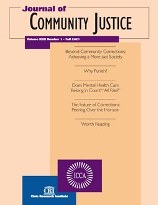Complete Issue
Author: Michael Gilbert.
Source: Volume 18, Number 01, Fall 2008 , pp.1-32(32)

< previous article |return to table of contents
Abstract:
This issue and the next issue of the Journal of Community Corrections will focus on restorative justice. In the summer of 2007, the first National Conference on Restorative Justice was held in Kerrville, Texas, at Schreiner University. More than 300 people from 20 countries attended the conference, and many working papers were presented by academics and practitioners. The positive reception to an inquiry by conference organizers from the leadership of the International Community Corrections Association and the editors of the ICCA Journal of Community Corrections has led to this issue. The first article by Dr. Jung Jin Choi links restorative justice theory with evidence-based best practices. In that process, Dr. Choi identifies a number of critically important elements for successful application of restorative justice principles and practices. Perhaps the most important of his findings are the central roles that cultural relevance and competency have to restorative applications. Reframing Advocacy in Restorative Justice Cases: The Milwaukee Community Conferencing Program by David Lerman and Tom Reed provides an in-depth discussion of the Milwaukee Community Conferencing Program. This unique program was implemented and is currently operated by the Milwaukee County District Attorney’s Office. David Lerman is a prosecutor and Tom Reed is a public defender. The authors identify a number of practical operational and administrative issues for the development and implementation of successful “front end” restorative justice program diversion programs. Their observations, which are drawn from first-hand experience operating the Community Conferencing Program, are also relevant to the implementation and operation of restorative justice programs operated by other justice system agencies and social service organizations. Bridges to Life: The Impact of an In-Prison Restorative Justice Intervention by Dr. Marilyn Armour, Mr. John Sage, Dr. Allen Rubin, and Dr. Liliane Windsor evaluates the Bridges to Life program that is offered in many Texas prisons. This program applies restorative theory, principles, and values in a faith-based context with inmates who are nearing release. This evaluation finds the program to be effective in reducing recidivism. The authors also provide theoretical insights and inferences about the “black box” of restorative processes that help readers understand what aspects of restorative processes are effective and suggest why they work as they do. These findings are important for both theory construction and program design. Taken as a whole, these articles provide a vision of justice that is less punitive than the usual model and is more effective, less costly, and more focused on healing victims, offenders, and the community. It is a vision in which victims’ needs are addressed and offenders have an opportunity to make amends to those they have harmed and are encouraged to take active steps to make amends as they earn redemption. It is a vision in which there is an opportunity for offenders to rebuild their lives and resume life as full citizens within the community. It is a hopeful, but also attainable, vision.Keywords:
Affiliations:
1: University of Texas at San Antonio.